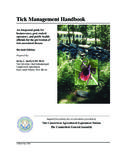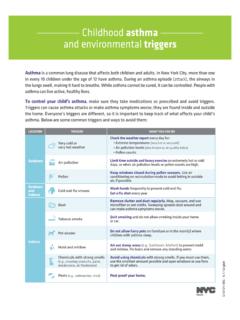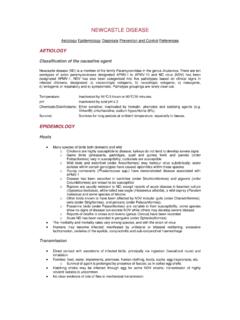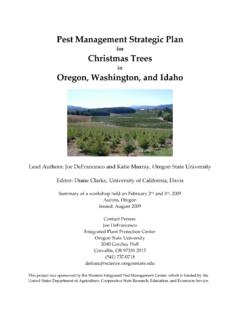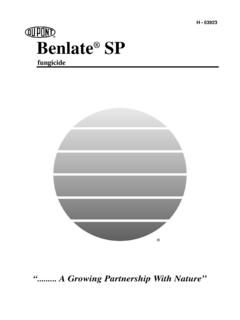Transcription of colour (Fig. 5.2a). The egg case measures 8–10mm …
1 288 CHAPTER 5 COCKROACHESCHAPTER 5 CockroachesUnhygienic scavengers in human settlementsCockroaches are among the most common pests in many homes and otherbuildings. At night they search for food in kitchens, food storage places, rubbishbins, drains and sewers. They are pests because of their filthy habits and bad people may become allergic to cockroaches after frequent exposure. Cock-roaches can sometimes play a role as carriers of intestinal diseases, such asdiarrhoea, dysentery, typhoid fever and are insects, flattened from top to bottom, usually with two pairs ofwings folded flat over the back (Fig. ). Most species rarely fly but they walk veryfast.
2 The colour usually varies from light brown to black. The species vary from 2 3 mm to over 80 mm in over 3500 identified species only a few are of importance to people becausethey have adapted to living in buildings. The most common species are: Periplaneta americana, the American cockroach, which occurs around theworld. It is 35 40 mm in length and is a shiny reddish to chocolate browncolour (Fig. ). The egg case measures 8 10 mm and contains 16 eggs. Periplaneta australasiae, the Australian cockroach, which occurs mainly intropical and subtropical areas. It is similar to the American cockroach, butsmaller (31 37 mm long) and darker (Fig. ).
3 It has a pale yellow stripeon each forewing extending for about one-third its length. The egg casecontains about 22 24 eggs. Blatta orientalis, the Oriental cockroach, found mainly in cool temperateregions. It is blackish and 20 27 mm long (Fig. ). The egg case is 10 12 mm long and contains 16 18 eggs. Supella longipalpa, the brown-banded cockroach, which occurs around theworld. It is 10 14 mm long and has yellow and brown bands (Fig. ). Theegg case is 4 5 mm in length and contains about 16 eggs. Blattella germanica, the German cockroach, found in most parts of the is light yellowish brown and 10 15 mm in length, making it one of thesmallest domestic cockroaches (Fig.)
4 The female usually carries the eggcase until shortly before the young come out. The egg case is light in colour ,about 7 9 mm long and contains about 40 cycleCockroaches are relatively primitive, having only three stages in their life cycle:egg, nymph and adult (Fig. ). The female deposits its eggs in groups sur-rounded by a leathery, bean-shaped egg case or capsule called an ootheca. SomeBIOLOGY289 Fig. view of a cockroach (Blattella germanica) ( WHO).Fig. most common cockroach species: (a) American cockroach, Periplaneta americana; (b) Austra-lian cockroach, Periplaneta australasiae; (c) Oriental cockroach, Blatta orientalis; (d) brown-bandedcockroach,Supella longipalpa; (e) German cockroach, Blattella germanica (by courtesy of the NaturalHistory Museum, London).
5 BIOLOGY289290 CHAPTER 5 COCKROACHES species, such as the German cockroach, carry the ootheca for several weeksattached to the back end of the body. Most others deposit the ootheca after one ortwo days. Oothecae are very distinctive and can frequently be used to determinethe species present. Depending on the species, temperature and humidity, the eggshatch after 1 3 young cockroaches, or nymphs, are wingless, and usually only a fewmillimetres long; they are white on hatching but darken within a few hours. Theygrow in stages by repeatedly shedding the cuticle or skin. They are fully grownafter several months to more than a year, depending on the species.
6 The adultsmay or may not possess wings, consisting of one outer leathery pair beneath whichis folded a membranous cockroaches live in close association with people (1,2). They are tropical inorigin but in the temperate zones most species live in parts of houses and otherbuildings where warmth, moisture and food are usually live in groups. They are mostly active at night; in thedaytime they hide in cracks and crevices in walls, door frames and furniture, andin secure places in bathrooms, cupboards, steam tunnels, animal houses, base-ments, televisions, radios and other electric devices, drains and sewer systems. Ifthe lights are turned on in an infested kitchen at night the cockroaches will runfrom dishes, utensils, working surfaces and the floor towards cycle of the German cockroach (by courtesy of the Natural History Museum, London).
7 BIOLOGY291 Fig. garbage bins offer anexcellent environment for cock-roaches to develop ( WHO).Cockroaches eat a great variety of food, including all food used for humanconsumption (Fig. ). They prefer starchy and sugary materials. They sip milkand nibble at cheese, meats, pastry, grain products, sugar and sweet also feed on cardboard, book bindings, ceiling boards containing starch, thesized inner lining of shoe soles, their own cast-off skins, dead and crippledcockroaches, fresh and dried blood, excrement, sputum, and the fingernails andtoenails of babies and sleeping or sick migrations have been reported for some species, apparently resulting fromovercrowding.
8 The migrants move into new areas by crawling or flying. Theycommonly enter houses in boxes of bottled drinks and bags of potatoes, onionsor other foodstuffs that have become infested in poorly maintained transportation of the pests can occur on aircraft, ships or health importanceNuisanceCockroaches are important pests because they spread filth and ruin food, fabricsand book-bindings. They disgorge portions of their partially digested food atintervals and drop faeces. They also discharge a nauseous secretion both from theirmouths and from glands opening on the body which give a long-lasting, offensivecockroach smell to areas or food visited by move freely from building to building or from drains, gardens, sewersand latrines to human habitations.
9 Because they feed on human faeces as well ashuman food they can spread germs that cause disease (Fig. ) (2,3). Cock-roaches are not usually the most important cause of a disease, but like housefliesBIOLOGY291292 CHAPTER 5 COCKROACHESFig. can spread disease by contaminating human food with germs they pick up in latrines,garbage dumps, may play a supplementary role in the spread of some diseases. They areproven or suspected carriers of the organisms causing: diarrhoea dysentery cholera leprosy plague typhoid fever viral diseases such as addition they carry the eggs of parasitic worms and may cause allergicreactions, including dermatitis, itching, swelling of the eyelids and more seriousrespiratory conditions (4).
10 Control measuresEffective control is easier in temperate climates (where cockroach populationscannot survive outdoors in winter) than in humid and warm areas. The key tocontrol is cleanliness, which may be difficult in houses where there are childrenand domestic animals. In isolated homes, control is easier to achieve than inapartments where cockroaches may have easy access from adjacent occurs from outdoors in warm areas, or along heating ducts andwater pipes in apartments, or from groceries or luggage brought from cockroach-infested areas. Cockroaches may even sometimes be found in very clean houses,but are unlikely to establish presence of several sizes of nymphs and oothecae is an indication of a well-established colony.










